Compressed Air System Installation Guide
Your CAS system is designed and built to give many years of efficient service. To ensure the system performs at its best, it is essential to
install it properly in line with industry best practices.
Whether you are updating an old compressed air system or installing a new one, we here at Compressed Air Systems want to help you
make it a success. We have compiled this installation guide to provide you with important information regarding location, ventilation
and other essential factors of the compressor installation process that will help you get the most out of your compressed air system.
This guide provides step-by-step instructions for installation. It will help you avoid problems caused by improper installation that could
lead to unscheduled downtime or equipment failure.
Correct installation provides a number of important benefits:
- Reduces unscheduled downtime
- Ensures energy-efficient operation
- Optimizes performance
- Reduces maintenance requirements
- Lowers Total Cost of Operations (TCO)
- Extends service life.
Carry out preparation and delivery inspection
Careful preparation is essential for a successful installation.
- Choose a suitable location for the unit following the recommendations
of this guide. - Ensure that all essential services and ancillary equipment are in place
and operational. - When the equipment is delivered, check the packaging for signs of damage
or interference. - If the packaging incorporates a Tip’n’Tell indicator, check its status.
- Inspect the unit carefully for damage in transit. If damage is serious,
the unit may have to be repaired or returned. - Check the inventory to ensure that nothing is missing.
- If there is no damage to the package, accept the product’s delivery
with a simple signature.
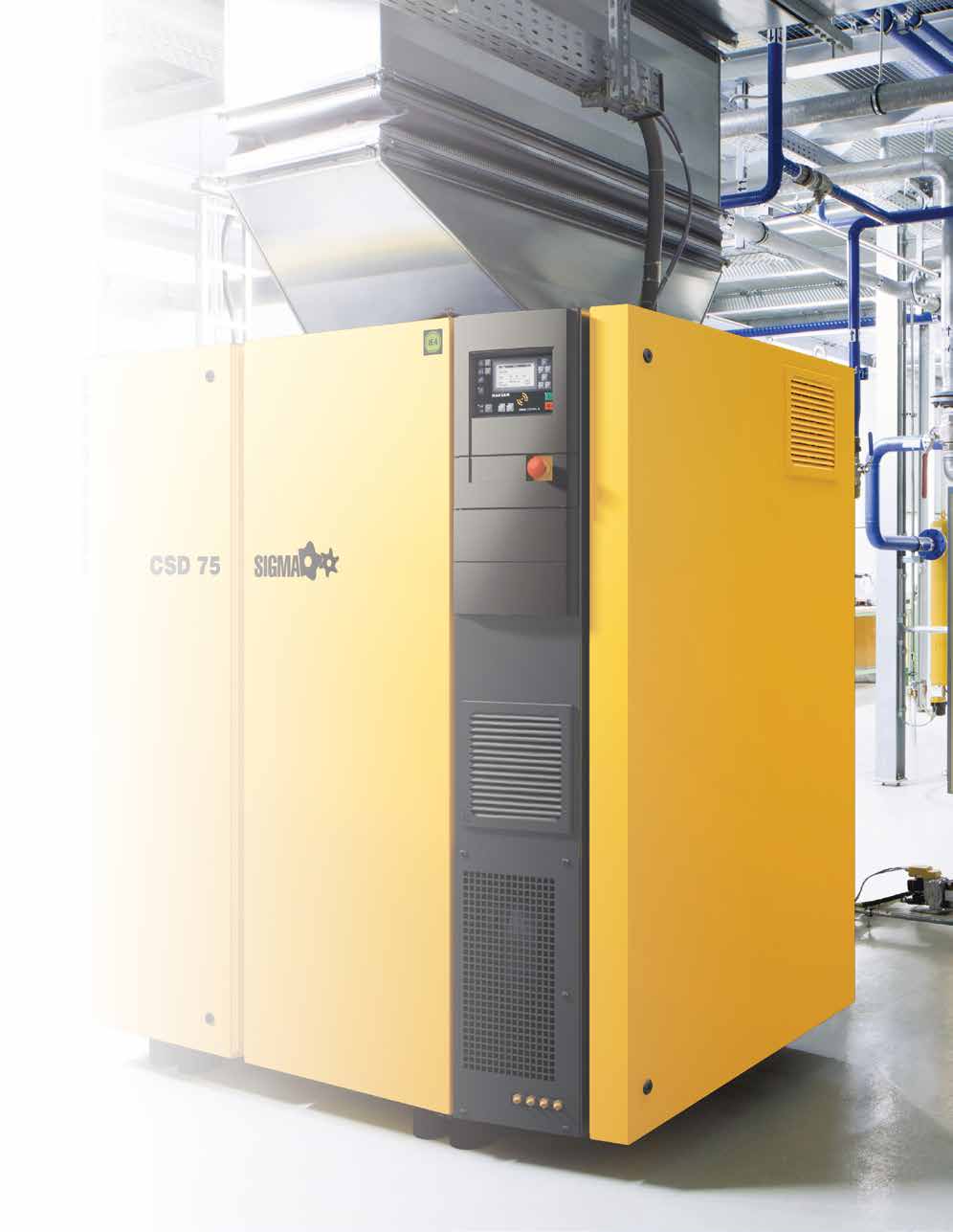
Choose a suitable location
Choosing a suitable location is important for the efficient operation, quality and life expectancy
of the equipment. While installation indoors is generally recommended, a number of factors may make
this difficult or adversely affect the equipment:
- High noise levels from the unit
- Dirty or dusty conditions in the facility
- High ambient temperatures in the area
- High levels of chemical concentration in the air.
Outdoor installation may make the equipment vulnerable to extreme temperatures and weather
conditions, as well as dirt, dust and moisture from the surrounding area. Outdoor installation may
also incur additional costs, including a concrete pad, additional ducting
and power supply and security measures such as fencing and shelter against weather conditions.
Check the suitability of the floor
Compressed air units installed indoors can be located on a standard concrete factory floor. They do not require special foundations or surface finish.
- Check that the floor is level, clean and capable of taking the weight of the unit, any ancillary equipment and the equipment used to move it into position.
- If noise is a problem, ensure the floor has the space and strength for a suitable enclosure.
Consider all access requirements
In selecting a suitable location for the equipment, make sure that the area has sufficient clearance for access at various stages of
installation, operation and maintenance.
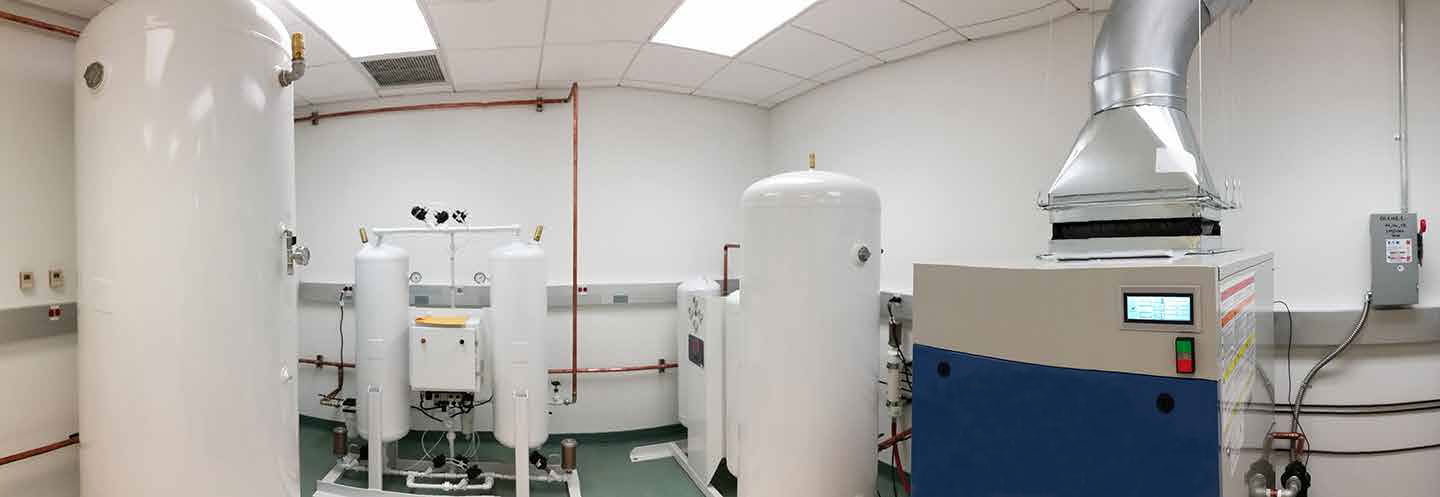
The area around the unit should allow:
- Access by fork lift, truck or crane for installation
- Installation of power supply, ducting and other services
- Ventilation in line with equipment specification
- Access by maintenance teams to operating panels or service points with a minimum of 40” clearance around the unit
- Access for repair or replacement of components.
Consider environmental factors
The quality of the environment can affect operational efficiency. Check that environmental conditions meet the following requirements:
- Maintain ambient temperatures within the recommended range for the model.
- Avoid low temperatures – they impede lubricant flow and create condensation. If necessary, install a suitable cabinet heater.
- Avoid high temperatures – they can reduce lubricant life and affect cooling and condensate management.
- Avoid high levels of dust or other particulates that can affect operation. Plan to change filters more frequently to protect equipment.
- Avoid excess moisture which can cause electrical problems or corrosion and affect lubrication efficiency.
- Avoid corrosive chemicals that can attack or contaminate internal components, filters and lubricants.
Provide correct ventilation
Correct ventilation is essential to the efficient operation of the equipment. It can also promote energy efficiency through heat recovery. Poor ventilation will not remove the heat, raising temperatures and reducing operational efficiency.
- For small units, up to 15hp, install louvered inlets and outlets.
- For larger units, over 20hp, it is recommended to supply forced ventilation.
- Isolate exhaust air from air inlets of other units.
- In extremely cold conditions, install thermostatically controlled louvers at air inlet and exhaust discharge points.
Install optional water cooling
Water cooling is an alternative to air cooling. To implement water cooling,
ensure ensure you have the following:
- Source of suitable water (filtered water yields better)
- Pumps, plumbing, piping and filtration equipment
- Heat exchangers
- Water treatment plant
- Chilling equipment
The additional equipment required can add to the cost. However, part of the cost can be offset by implementing a heat recovery program.
- Install connections from discharged cooling water to a heating application or an industrial process that requires hot water.
- Use the heat recovery program to reduce overall energy costs.
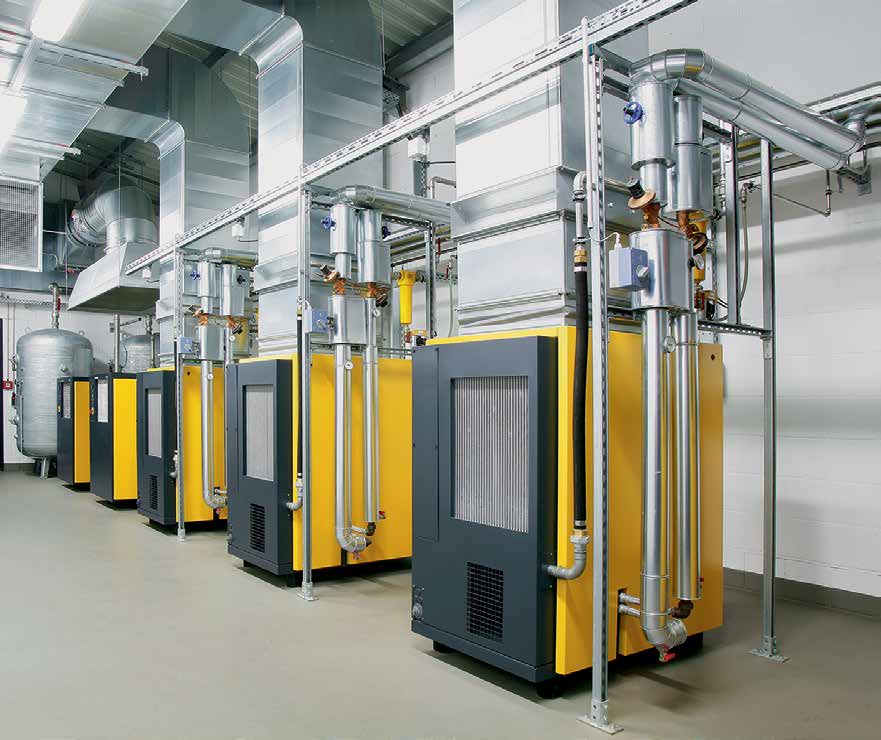
Provide a safe, compliant power supply
To protect the equipment and the safety of the operators, follow recommendations for the correct electricity supply and comply
with electrical safety regulations.
- Ensure that operating voltage meets the equipment specification.
- Provide a separate supply for each unit, unless it is a du-, tri- or quad-plex with a single master controller provided from the factory.
- Ensure correct grounding using a fuse or circuit breaker.
― Proper wire size is critical for optimal grounding.
― Always use the same size ground wire as the incoming wire size on a variable speed drive. - Work should only be carried out by qualified electrical contractors.
- Electrical work must comply with local and national codes and regulations.
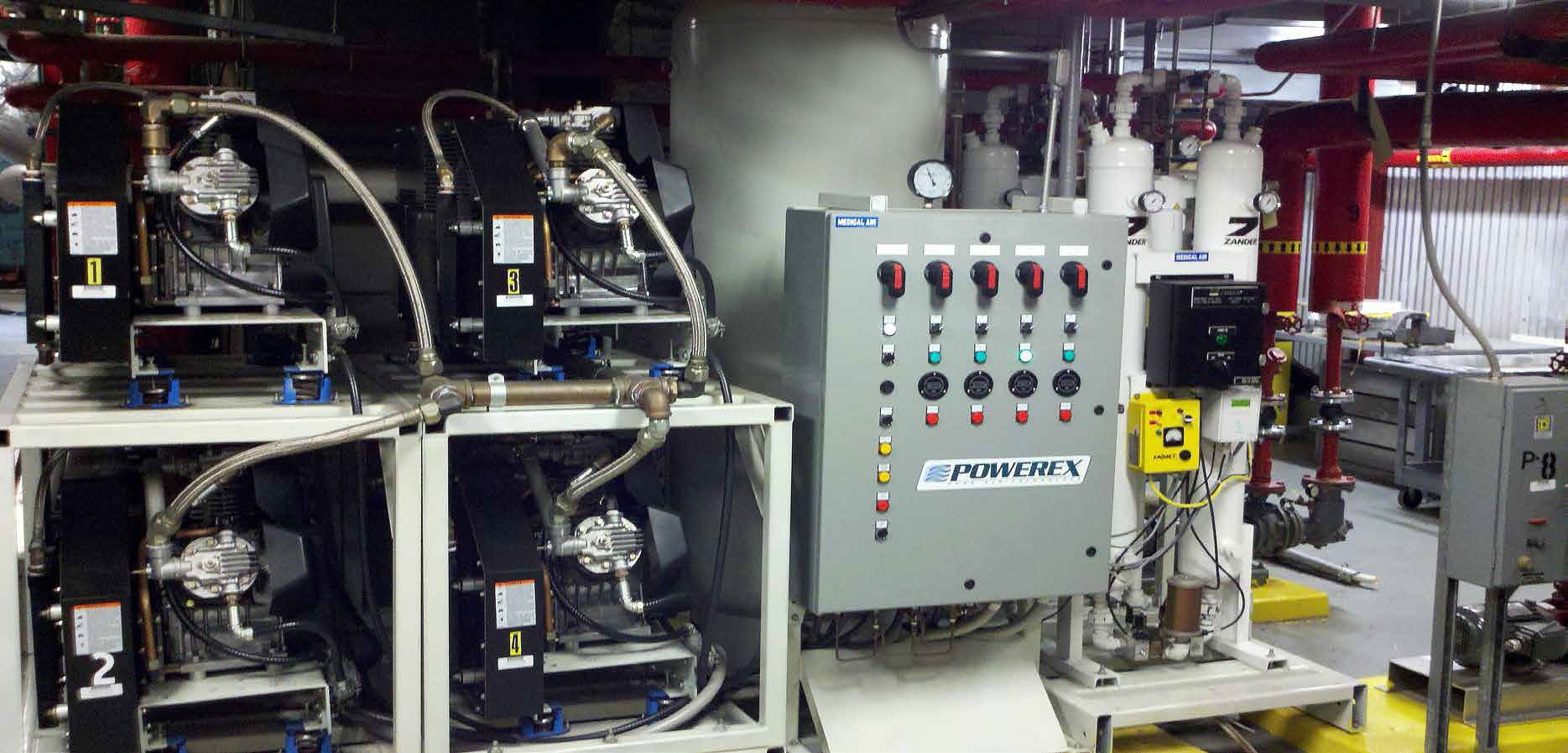
Enhance efficiency with master controllers
To enhance efficiency when using multiple air compression units, install a master controller. Some available models can control up to 16 units.
These controllers provide a number of important benefits:
- Maintain lower operating pressures to reduce energy consumption
- Control maintenance costs by balancing operating hours and reducing cold starts
- Reduce downtime and improve equipment performance
- Manage oily condensate
- Web-based, remote monitoring of compressor systems, including alarms, maintenance and daily performance, with real-time data, energy usage, flow, pressure, temperature, etc.
Ensure air purity
The Clean Water Act of 1970 was created by the Environmental Protection Agency (EPA), a federal entity that strictly enforces the disposal
regulations of oily compressor condensate. In fact, most condensate contains more than 300 ppm of oil, which is illegal to dispose of directly
into drains. Due to this fact, the EPA requires a condensation management system that minimizes the amount of oil in the water (most
municipalities accept < 100 ppm). For example, a 100 HP compressor can pass up to 10 gallons of oil per year in one-shift environment.
The system collects the contaminated water at each filter, dryer and water separator in a drain trap and channels it to the condensate
cleaner, which separates the oil from the water. To reduce the risk of contamination by oil, moisture or particulates, it is essential to set up
the correct combination and sequence of filters, receivers and dryers.
- Select the combination of filters, receivers and dryers to suit the application and airflow rating.
- Select dryers based on the dew point for the application and apply correction factors for ambient conditions—this is especially important in tropical climates.
- As a guideline, treat smaller amounts of compressed air for specific applications, rather than treating the entire supply to achieve the highest purity level.
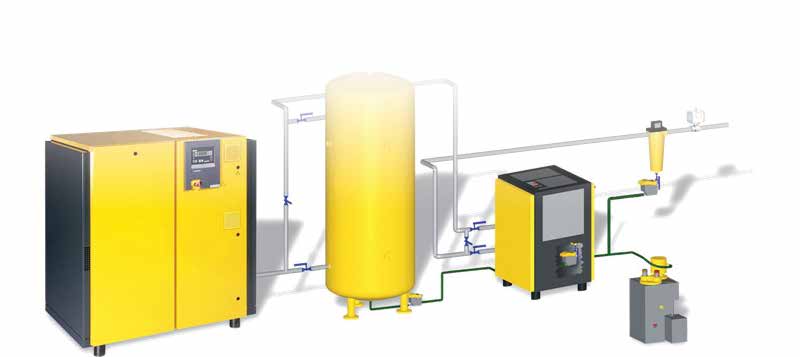
All compressors form condensate that is mostly made up of water. Condensate becomes contaminated with oil from within the compressor and particles that have been drawn into and passed through the compressor.
To avoid problems caused by condensation, it is highly recommended that you install a condensation system composed of drain taps,
oil/water separators and the necessary manifold and piping to connect them.
The first step is to remove the moisture from the air, and it starts with air coolers (or aftercoolers), moisture separators, air dryers
and moisture drain valves. The air coolers lower the compressed air temperature and moisture separators collect and dispose of the
moisture from this process. Air dryers remove the remaining moisture, and moisture drain valves channel the contaminated water
and allow disposal.
After this process, filters remove the remaining oil particles, oil, vapors, etc. Air filters clean the air, and coalescing filters remove
the oil mist. Other types of filters can also be installed for odors and bacteria. Filters are installed upstream of regulators and lubricators
to protect them.
Drain traps can be manually operated, float-operated, timer-controlled (automated), or feature an electronic sensor. This choice is
driven by cost and drain location. Less automated drains can waste compressed air and output a mist, which is complicated to manage.
These drains also get stuck if they are not handled often. However, they are cheaper than a fully automated system and require less
complicated installation.
A zero loss drain is often the preferred and most efficient choice.
Condensate oil water separators use a combination of technologies to separate water from oil, including gravity, oil-absorbing prefilters
and activated filter bags. The oil is usually collected in a separate container, allowing the disposal of water with contamination within the
legal limit. Some separators have a tap to be able to sample the output without taking if offline.
Plan and install efficient piping
In order to provide ample airflow and steady pressure to all system points it is important to correctly size the pipework of your
system. The diameter of the pipe determines the pressure drop across the pipework.
The Compressed Air and Gas Institute (CAGI) has published tables to estimate the pressure drop from friction loss at specific pressures.
The type of piping material you choose will have a large impact on your system’s airflow, pressure and air quality. Poor choices of
material, diameter and layout will cause restrictions that result in significant pressure drops across the system. PVC and ABS
material are not recommended. Certain synthetic lubricants can degrade these plastics and lead to ruptures, which is a health hazard.
Additionally, air traveling through plastic pipes can accumulate a static electric charge that can discharge when an employee touches it.
For this reason, PVC and ABS piping are not recommended by the Occupational Safety and Health Administration (OSHA).
- Follow CAGI recommendations for Pressure Loss
- Use rounded elbows whenever possible
- Avoid the use of “T”s and right angles that increase friction loss
- Pipe in the bottoms and tops of air receiver tanks to promote moisture separation
- Use braces to secure pipes to walls, floors or ceilings to prevent movement and stress on pipe joints
- Use Flexible pipe/hose connections between rigid air piping and compressor discharge outlets
- Aluminium and copper are preferred materials for pipes galvanized steel piping can still be utilized but will tend to leak after time at threaded connections
To optimize and maintain pressure in the system, select the correct piping size and material.
- Follow the recommendations of the Compressed Air and
- Gas Institute to calculate potential pressure loss in a system
- Plan pipe flows to minimize bends that create friction and reduce pressure. Round elbows help reduce friction, compared to right angles
- Select materials that have a smooth interior and low pressure drop
- Brace pipes to minimize the risk of movement
- Connecting all the piping together in a “loop”offers the air a path of least resistance
Contact Compressed Air Systems Today
Having a fully-functional and efficient air compression system is important for your business. Ensure that you follow all
installation instructions to get the most out of your system.
For more information on proper equipment installation, contact Compressed Air Systems. Our expert technicians and
experienced sales staff have years of combined experience serving customers in various industries. Find out how we
can help you with all your compressed air and gas system needs.

